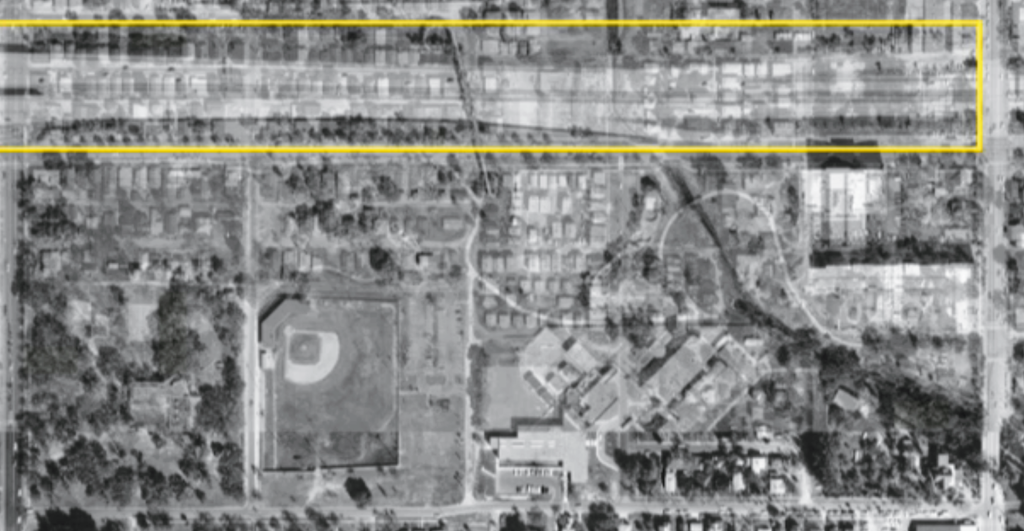When construction of Interstate 175 began in the late 1970s, South St. Petersburg neighborhoods were bifurcated. According to city reports, nearly 4,000 people – and 2,700 African American families and businesses – were displaced.
Local leaders now hope to rectify past mistakes. Congresswoman Kathy Castor joined Mayor Ken Welch in the interstate’s shadow Tuesday at Campbell Park to unveil plans for the Reconnecting the Historic Gas Plant District project.
They said the project would improve safety, access, mobility, air quality and economic improvement opportunities in disadvantaged, predominantly Black communities in South St. Pete. City officials recently submitted a $1.2 million U.S. Department of Transportation grant application to fund the planning phase.
“All across America right now, communities are reexamining mistakes that were made over 50 years ago when the interstate highway system was planned,” Castor said. “But when you look at what happened here in St. Petersburg, it just screams out for a reexamination of ways to reconnect the neighborhoods.”
If approved, the money would stem from the Reconnecting Communities and Neighborhoods (RCN) Community Planning Grant Program. Castor said increasing city cohesiveness and walkability would help small businesses thrive and support affordable housing efforts.
She added that “you can develop a healthier community if you do not have an interstate running smack-dab through your neighborhood.” Castor pledged to ensure the federal funding serves its intended purpose in St. Petersburg.
Welch noted that his grandfather’s lumber company, Welch’s Woodyard, once sat across the street from the location of Tuesday’s press conference. The business was one of hundreds displaced to make room for the interstate.
Welch reiterated the former Gas Plant District’s oft-repeated fate. City officials promised jobs and revitalization; predominantly Black residents received Tropicana Field and its sprawling parking lots instead.
“It’s time for all of that to change,” Welch said. “The proposed agreement that my administration has crafted with the Hines/Rays (development) group and Pinellas County, I think, represents a clear path to that goal of economic inclusion.”
The walled, limited-access interstate and several adjacent one-way streets disjoin South St. Pete neighborhoods from the rest of the city. Welch said the funding would support an 18-month, community-informed planning project.
Local leaders believe the project will help address the following issues:
- Safety: High vehicle speeds result in accident “hotspots” and increase the likelihood of bicycle and pedestrian crashes with severe or fatal injuries.
- Access & Mobility: Preliminary planning calls for two-way street conversions and lane reallocations on 8th Street and Dr. Martin Luther King Jr. Street that will improve pedestrian and bike travel. Officials also expect the changes will allow for creative place-making and green infrastructure, including curb extensions and street trees.
- Environmental: Pollution disproportionately affects several area neighborhoods. Those disadvantaged communities also suffer from poor air quality and increased diesel particulate matter exposure.
- Economic: Adjacent neighborhoods lack connectivity to city employment and business districts, resulting in lower median household incomes.
“We have a historic opportunity to do just what the grant says – reconnect our community and continue with our push for inclusive progress with partners like Congresswoman Castor,” Welch said.


A map showing how I-175 split historically Black neighborhoods. Image: City documents.
The 2022 Downtown Mobility Study helped inform the project. Whit Blanton, CEO of Forward Pinellas, noted that his organization, the city council and the Florida Department of Transportation (FDOT) supported its findings.
Blanton said those included the benefits of converting one-way streets and a “commitment to examine the footprint of Interstate 175.” He noted that FDOT officials committed to launching an I-175 action plan next year “to determine the best course of action.”
City Council Vice Chair Deborah Figgs-Sanders called the announcement a momentous occasion. She said the $1.2 million represented a pivotal investment in South St. Pete’s future and “an acknowledgment of the unique challenges faced by the Historic Gas Plant.”
“This is not just about changing streets,” Figgs-Sanders added. “It’s about transforming lives and creating a future filled with opportunities for every resident.”


